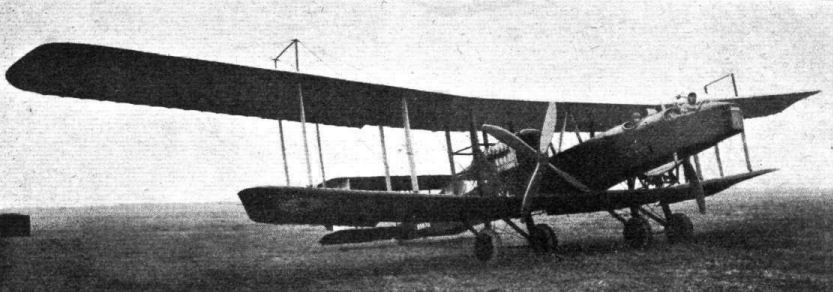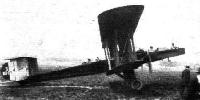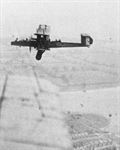
Описание
Страна : Великобритания
Год : 1917
Бомбардировщик и дальний противолодочный самолет с экипажем из трех человек
Варианты
- Blackburn - GP - 1916 - Великобритания
- Blackburn - Kangaroo / R.T.1 - 1917 - Великобритания
Blackburn RT.1 Kangaroo
На основе гидропланов GP и SР был разработан сухопутный разведчик/торпедоносец Blackburn RT.1 Kangaroo с двумя моторами Falcon II мощностью по 250 л.с. Официальные испытания прототипа начались в январе 1918 года. В ходе испытаний проявился ряд недоработок, тем не менее, была заказана партия из 20 машин (вместо 20 гидросамолетов GP).
В 1918 году первые Kangaroo поступили на вооружение 246-й эскадрильи. Начиная с шестого экземпляра, они комплектовались моторами Rolls-Royce Falcon III. За шесть месяцев боевых действий Kangaroo потопили одну подводную лодку и повредили еще четыре. С окончанием Первой мировой войны уцелевшие машины были проданы гражданским организациям, три - "Grahame White Aviation Со.", восемь - "North Sea Aerial Navigation Co. Ltd.". После переделки самолет мог перевозить по восемь пассажиров. Kangaroo эксплуатировались достаточно интенсивно. На одном из них в 1919 году попытались выиграть приз в 10 000 фунтов стерлингов за перелет из Англии в Австралию, но самолет получил повреждения при вынужденной посадке на Крите и был разобран на запчасти. Последние самолеты использовались как учебно-тренировочные в составе британских ВВС и были оснащены двойным управлением. В 1929 году последний Kangaroo списали.
ТАКТИКО-ТЕХНИЧЕСКИЕ ХАРАКТЕРИСТИКИ
Blackburn RT.1 Kangaroo
Тип: бомбардировщик и дальний противолодочный самолет с экипажем из трех человек
Силовая установка: два V-образных мотора Rolls-Royce Falcon III мощностью по 270 л. с.
Характеристики: максимальная скорость на высоте 1980 м 158 км/ч; крейсерская скорость на высоте 3050 м 138 км/ч; скороподъемность 358 м/мин; абсолютный потолок 3960 м; продолжительность полета 9 ч
Масса: пустого 2397 кг; максимальная взлетная 2852 кг
Размеры: размах крыла 22,82 м; длина 13,46 м; высота 5,13 м; площадь крыльев 80,64 м2
Вооружение: два 7,7-мм пулемета Lewis, до 445 кг бомб на внутренней и внешней подвеске
Описание:
- Blackburn RT.1 Kangaroo
- Flight, December 1919
The "Kangaroo" Bombing Aeroplane.
Фотографии
-
Мировая Авиация 57
Регистрационный номер: B9976 [2] B9976 был передан заказчику в мае 1918 года, это один из 19 серийных самолетов Kangaroo. Самолеты данного типа предназначались для борьбы с подводными лодками и ночных бомбардировок, но в качестве бомбардировщиков их не использовали.
-
Flight 1919-12 / Flight
Регистрационный номер: B9970 [2] The first Kangaroo (B9970) with the original unsprung undercarriage and shallow front cockpit and two Rolls-Royce engines.
-
Aeroplane Monthly 1979-08 / A.Jackson - Blackburn's Marsupial
Регистрационный номер: B9970 [2] The prototype Kangaroo, B9970, at Brough in December 1917, with the original nose cockpit.
-
Flight 1922-09 / Flight
The Blackburn Kangaroo, 2-275 h.p. Rolls-Royce "Falcons"
-
Air Pictorial 1961-12 / J.Bruce - Blackburn Kangaroo /Aircraft of 1914-18 War/
Регистрационный номер: B9974 Kangaroo with raised front gun ring and sprung undercarriage
-
Aeroplane Monthly 1979-08 / A.Jackson - Blackburn's Marsupial
Регистрационный номер: B9976 [2] Kangaroo B9976 of No 246 Squadron bombed up at Seaton Carew in 1918, showing the revised nose cockpit.
-
Aeroplane Monthly 1979-08 / A.Jackson - Blackburn's Marsupial
Регистрационный номер: B9985 [3], G-EADG [3] G-EADG joyriding at Hendon in RAF colours as B9985 in June 1919.
-
Aeroplane Monthly 1979-08 / A.Jackson - Blackburn's Marsupial
Регистрационный номер: B9985 [3], G-EADG [3] The Grahame-White Company's joy-riding Kangaroo B9985, properly G-EADG, flying near Hendon in May 1919. Two large cockpits behind the wings accommodated seven passengers; hardier souls braved the air in the front cockpit which, as can be seen here, latterly had no windbreak of any kind.
-
Flight 1939-05 / Flight
The Blackburn Kangaroo, developed from the “G.P.,” was designed for night bombing and anti-submarine patrol. Shown here is a post-war civil version, operated for a time by the Grahame-White company.
-
Aeroplane Monthly 1979-05 / Hendon /Gone but not forgotten/ (2)
In 1919 Grahame-White purchased three surplus RAF Blackburn Kangaroo bombers and converted them into eight-seat joy-riders. One of these aircraft is depicted here, flying over the Welsh Harp reservoir in 1919. Note the lucky passenger perched in the nose.
-
Aeroplane Monthly 1979-08 / A.Jackson - Blackburn's Marsupial
Регистрационный номер: G-EADG [3], B9985 [3] Grahame-White's Kangaroo G-EADG in full civilian markings in September 1919.
-
Air Pictorial 1961-12 / J.Bruce - Blackburn Kangaroo /Aircraft of 1914-18 War/
Регистрационный номер: G-EAIT [2] G-EAIT - первый гражданский Kangaroo авиакомпании "Норт Си Эйриэл Нэвигэйшн Со.", разбившийся 5 мая 1925г. Самолет оборудован закрытой кабиной для семи пассажиров. Носовая стрелковая турель демонтирована, а вместо нее устроено место для восьмого пассажира.
One of the two cabin Kangaroos, G-EAIT was used on the Leeds-Hounslow-Amsterdam service of the North Sea Aerial Navigation Co. in 1919-20. Its liberal markings included the full civil registration in duplicate on the fins and rudders -
Aeroplane Monthly 1979-08 / A.Jackson - Blackburn's Marsupial
Регистрационный номер: G-EAIT [2] R. W. Kenworthy taking off in Blackburn Kangaroo G-EAIT (note registration also under tailplanes) at the ELTA exhibition, Amsterdam, in August 1919.
-
Aeroplane Monthly 1979-08 / A.Jackson - Blackburn's Marsupial
Регистрационный номер: G-EAIU [3] G-EAIU, second King's Cup entrant, carrying the company title in the newly-adopted Rockwell Italic styling.
Flown by R. W. Kenworthy in the 1922 King's Cup race, G-EAIU was one of the Kangaroos that could carry freight or passengers -
Aeroplane Monthly 1979-08 / A.Jackson - Blackburn's Marsupial
Регистрационный номер: G-EAIU [3] The same aircraft taking off from Croydon at the start of the King's Cup Race, September 8, 1922.
-
Aeroplane Monthly 1979-08 / A.Jackson - Blackburn's Marsupial
Регистрационный номер: G-EAIU [3] Capt S. J. Woolley makes a lively takeoff at the ELTA exhibition, August 1919.
-
Aeroplane Monthly 1979-08 / A.Jackson - Blackburn's Marsupial
Регистрационный номер: G-EAKQ Kenworthy and Bancroft at Amsterdam with G-EAKQ on March 6, 1920, at the end of the first commercial service from Brough.
-
Aeroplane Monthly 1979-08 / A.Jackson - Blackburn's Marsupial
Регистрационный номер: G-EAMJ This Kangaroo, G-EAMJ, was entered for the 1922 King's Cup race by the Rt. Hon. Winston Churchill, M.P. It was one of the cabin-type passenger carriers, but its cabin top was faired off a little better than that of G-EAIT. Note the gravity tank above the centre-section. September 8, 1922.
-
Aeroplane Monthly 1979-08 / A.Jackson - Blackburn's Marsupial
Регистрационный номер: G-EBOM G-EBOM Pip, second of the final three trainer version of the Kangaroo with modified nose and dual control in the two front cockpits
-
Air Pictorial 1961-12 / J.Bruce - Blackburn Kangaroo /Aircraft of 1914-18 War/
One unit of the revised undercarriage, with plywood fairings on the forward legs. Engine bearers and oil tank can also be seen
-
Air Pictorial 1961-12 / J.Bruce - Blackburn Kangaroo /Aircraft of 1914-18 War/
Регистрационный номер: B9980 Dashboard of Kangaroo B9980. At top centre is the compass, to its left the altimeter, to its right the airspeed indicator. The two white dials in the centre are the fuel gauges; at the extreme left are the main ignition switches, at extreme right the fuel selector levers. The two r.p.m. indicators are at the bottom left and right.
-
Aeroplane Monthly 1979-08 / A.Jackson - Blackburn's Marsupial
Регистрационный номер: G-EAOW Kangaroo G-EAOW after its single-engine forced landing in Crete, December 8, 1919.
-
Aeroplane Monthly 1979-08 / A.Jackson - Blackburn's Marsupial
Регистрационный номер: B9982, G-EADF The wreck of Kangaroo B9982/G-EADF immediately after its crash at Hendon on May 31, 1919.
-
Flight 1939-04 / Flight
HISTORICAL: This 6-ft. span model of the famous Blackburn Kangaroo has been presented to Hull Municipal Museums by Blackburn Aircraft Ltd The Kangaroo (with two Sunbeam engines and later with Rolls-Royce Falcons) was designed in 1916 as a bomber and submarine spotter and a number were constructed as landplanes. After the war some were modified for passenger transport, as seen in the model. They were also used for the training of R.A.F. Reserve officers at Brough until as late as 1929.
-
Air Pictorial 1961-12 / J.Bruce - Blackburn Kangaroo /Aircraft of 1914-18 War/
BLACKBURN KANGAROO (Original design with ventral gun position)
-
Air Pictorial 1961-12 / J.Bruce - Blackburn Kangaroo /Aircraft of 1914-18 War/
BLACKBURN KANGAROO (Production model)
- Фотографии

























